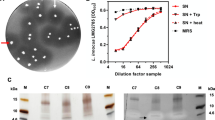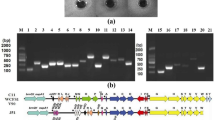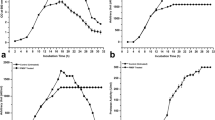Abstract
Carnobacterium maltaromaticum UAL26 produces the antimicrobial peptides (bacteriocins) piscicolin 126, first isolated from C. maltaromaticum JG126, and carnobacteriocin BM1, first isolated from C. maltaromaticum LV17. C. maltaromaticum UAL26 is especially inhibitory to strains of Listeria monocytogenes. Bacteriocin activity is not observable in the supernatant of cultures of UAL26 grown in liquid media at 25°C, but at temperatures less than 19°C bacteriocin activity can be detected. In contrast to JG126, the piscicolin 126 operon is downregulated in UAL26 at higher temperature, and piscicolin 126 mRNA is not detected when UAL26 is grown at 25°C. Bacteriocin production in UAL26 grown at 15°C can be induced by addition of 10−10 M of chemically synthesized piscicolin 126 induction peptide (PisN). However, induction of bacteriocin production in UAL26 grown at 25°C requires 10−7 M of PisN. The sequence of the piscicolin 126 operon in UAL26 contains 34 single nucleotide differences compared with the piscicolin 126 operon in JG126, including single nucleotide differences in the immunity, histidine kinase, dedicated ABC-transporter and accessory genes, as well as a single nucleotide deletion in the transport accessory gene. This deletion causes a frameshift, resulting in truncation of the PisE transport accessory protein in UAL26.




Similar content being viewed by others
Abbreviations
- ABC:
-
ATP binding cassette
- LAB:
-
Lactic acid bacteria
- AU:
-
Arbitrary units
- AP:
-
All-Purpose
- APT:
-
All-Purpose Tween
- MALDI-TOF:
-
Matrix assisted laser desorption/ionization-time-of-flight
- DEPC:
-
Diethyl pyrocarbonate
- RP-HPLC:
-
Reverse-phase HPLC
- IP:
-
Induction peptide
References
Ahn C, Stiles ME (1990) Antibacterial activity of lactic acid bacteria isolated from vacuum-packaged meats. J Appl Bacteriol 69:302–310
van Belkum MJ, Kok J, Venema G (1992) Cloning, sequencing, and expression in Escherichia coli of lcnB, a third bacteriocin determinant from the lactococcal bacteriocin plasmid p9B4-6. Appl Environ Microbiol 58:572–577
Buchanan RL, Klawitter LA (1992) Characterization of a lactic acid bacterium, Carnobacterium piscicola LK5, with activity against Listeria monocytogenes at refrigeration temperatures. J Food Safety 12:199–217
Burns KA (1987) Potential of a lactic acid bacterium for the biological preservation of ground beef. MSc thesis, University of Alberta, Edmonton, Alberta
Campos CA, Mazzotta AS, Montville TJ (1997) Inhibition of Listeria monocytogenes by Carnobacterium piscicola in vacuum-packaged cooked chicken at refrigeration temperatures. J Food Safety 17:151–160
Cintas LM, et al (2000) Biochemical and genetic evidence that Enterococcus faecium L50 produces enterocins L50A and L50B, the sec-dependent enterocin P, and a novel bacteriocin secreted without an N-terminal extension termed enterocin Q. J Bacteriol 182:6806–6814
Delgado A, Brito D, Peres C, Noe-Arroyo F, Garrido-Fernandez A (2005) Bacteriocin production by Lactobacillus pentosus B96 can be expressed as a function of temperature and NaCl concentration. Food Microbiol 22:521–528
Diep DB, Axelsson L, Grefsli C, Nes IF (2000) The synthesis of the bacteriocin sakacin A is a temperature-sensitive process regulated by a pheromone peptide through a three-component regulatory system. Microbiology 146:2155–2160
Diep DB, Johnsborg O, Risoen PA, Nes IF (2001) Evidence for dual functionality of the operon plnABCD in the regulation of bacteriocin production in Lactobacillus plantarum. Mol Microbiol 41:633–644
Diep DB, Myhre R, Johnsborg O, Aakra A, Nes IF (2003) Inducible bacteriocin production in Lactobacillus is regulated by differential expression of the pln operons and by two antagonizing response regulators, the activity of which is enhanced upon phosphorylation. Mol Microbiol 47:483–494
Franz CM, Schillinger U, Holzapfel WH (1996) Production and characterization of enterocin 900, a bacteriocin produced by Enterococcus faecium BFE 900 from black olives. Int J Food Microbiol 29:255–270
Franz CMAP, van Belkum MJ, Worobo RW, Vederas JC, Stiles ME (2000) Characterization of the genetic locus responsible for production and immunity of carnobacteriocin A: the immunity gene confers cross-protection to enterocin B. Microbiology-UK 146:621–631
Garneau S, Martin NI, Vederas JC (2002) Two-peptide bacteriocins produced by lactic acid bacteria. Biochimie 84:577–592
Gibbs GM, Fitzgerald A, Selleck ML, Harmark K, Hillier AJ, Davidson BE (2000) Carnobacterium piscicola putative piscicolin 126 immunity protein PisI (pisI), piscicolin 126 protein PisA precursor (pisA), piscicolin 126 induction factor PisN precursor (pisN), putative histidine kinase PisK (pisK), putative response regulator PisR (pisR), putative ABC transporter PisT (pisT), and putative accessory protein PisE (pisE) genes, complete cds. In: NCBI-BLAST
Hindre T, Le Pennec JP, Haras D, Dufour A (2004) Regulation of lantibiotic lacticin 481 production at the transcriptional level by acid pH. FEMS Microbiol Lett 231:291–298
Huot E, Barrena-Gonzalez C, Petitdemange H (1990) Tween 80 effect on bacteriocin synthesis by Lactococcus lactis subsp. cremoris J46. Lett Appl Microbiol 22:307–310
Jack RW, et al (1996) Characterization of the chemical and antimicrobial properties of piscicolin 126, a bacteriocin produced by Carnobacterium piscicola JG126. Appl Environ Microbiol 62:2897–2903
Keren T, Yarmus M, Halevy G, Shapira R (2004) Immunodetection of the bacteriocin lacticin RM: analysis of the influence of temperature and Tween 80 on its expression and activity. Appl Environ Microbiol 70:2098–2104
Kleerebezem M, Quadri LEN, Kuipers OP, De Vos WM (1997) Quorum sensing by peptide pheromones and two-component signal-transduction systems in gram-positive bacteria. Mol Microbiol 24:895–904
Kleerebezem M, Kuipers OP, De Vos WM, Stiles ME, Quadri LEN (2001) A two-component signal-transduction cascade in Carnobacterium piscicola LV17B: two signaling peptides and one sensor-transmitter. Peptides 22:1597–1601
Limonet M, Revol-Junelles AM, Cailliez-Grimal C, Milliere JB (2004) Synergistic mode of action of mesenterocins 52A and 52B produced by Leuconostoc mesenteroides subsp. mesenteroides FR 52. Curr Microbiol 48:204–207
Martin NI, et al (2004) Structural characterization of lacticin 3147, a two-peptide lantibiotic with synergistic activity. Biochemistry 43:3049–3056
Mora D, Scarpellini M, Franzetti L, Colombo S, Galli A (2003) Reclassification of Lactobacillus maltaromicus (Miller et al. 1974) DSM 20342(T) and DSM 20344 and Carnobacterium piscicola (Collins et al. 1987) DSM 20730(T) and DSM 20722 as Carnobacterium maltaromaticum comb. nov. Int J Syst Evol Microbiol 53:675–678
Moretro T, Aasen IM, Storro I, Axelsson L (2000) Production of sakacin P by Lactobacillus sakei in a completely defined medium. J Appl Microbiol 88:536–545
Mulet-Powell N, Lacoste-Armynot AM, Vinas M, De Buochberg MS (1998) Interactions between pairs of bacteriocins from lactic bacteria. J Food Prot 61:1210–1212
Nilsson L, Nielsen MK, Ng Y, Gram L (2002) Role of acetate in production of an autoinducible class IIa bacteriocin in Carnobacterium piscicola A9b. Appl Environ Microbiol 68:2251–2260
Nissen-Meyer J, Holo H, Håvarstein LS, Sletten K, Nes IF (1992) A novel lactococcal bacteriocin whose activity depends on the complementary action of two peptides. J Bacteriol 174:5686–5692
Papathanasopoulos MA, et al (1997) Multiple bacteriocin production by Leuconostoc mesenteroides TA33a and other Leuconostoc/Weissella strains. Curr Microbiol 35:331–335
Parente E, Hill C (1992) A comparison of factors affecting the production of two bacteriocins from lactic acid bacteria. J Appl Bacteriol 73:290–298
Pilet MF, Dousset X, Barre R, Novel G, Desmazeaud M, Piard JC (1995) Evidence for two bacteriocins produced by Carnobacterium piscicola and Carnobacterium divergens isolated from fish and active against Listeria monocytogenes. J Food Prot 58:256–262
Quadri LEN (2003) Regulation of class II bacteriocin production by cell–cell signalling. J Microbiol 41:175–182
Quadri LEN, Sailer M, Roy KL, Vederas JC, Stiles ME (1994) Chemical and genetic characterization of bacteriocins produced by Carnobacterium piscicola LV17B. J Biol Chem 269:12204–12211
Rose NL, Sporns P, McMullen LM (1999) Detection of bacteriocins by matrix-assisted laser desorption/ionization time-of-flight mass spectrometry. Appl Environ Microbiol 65:2238–2242
Sambrook J, Russell DW (2001) Molecular cloning: a laboratory manual. 3rd edn. Cold Spring Harbor Laboratory, Cold Spring Harbor, NY
Sashihara T, Dan M, Kimura H, Matsusaki H, Sonomoto K, Ishizaki A (2001) The effect of osmotic stress on the production of nukacin ISK-1 from Staphylococcus warneri ISK-1. Appl Microbiol Biotechnol 56:496–501
Saucier L, Paradkar AS, Frost LS, Jensen SE, Stiles ME (1997) Transcriptional analysis and regulation of carnobacteriocin production in Carnobacterium piscicola LV17. Gene 188:271–277
Tagg JR, Dajani AS, Wannamaker LW (1976) Bacteriocins of gram-positive bacteria. Bacteriol Rev 40:722–756
Wallbanks S, Martinez-Murcia AJ, Fryer JL, Phillips BA, Collins MD (1990) 16S rRNA sequence determination for members of the genus Carnobacterium and related lactic acid bacteria and description of Vagococcus salmoninarum sp. nov. Int J Syst Bacteriol 40:224–230
World Health Organization (1996) The World Health Report: fighting disease, fostering development. In: World Health Organization, Geneva, Switzerland, pp 37–45
Acknowledgments
We would like to give special acknowledgement to Denise Rivard and Adam Olson. We gratefully acknowledge the Natural Sciences and Engineering Research Council for providing scholarship assistance and Discovery grant funding, Alberta Ingenuity for a Studentship Award, and the Canada Research Chair in Bioorganic and Medicinal Chemistry and the Advanced Food and Biomaterials Networks of Centres of Excellence for financial support.
Author information
Authors and Affiliations
Corresponding author
Electronic supplementary material
Rights and permissions
About this article
Cite this article
Gursky, L.J., Martin, N.I., Derksen, D.J. et al. Production of piscicolin 126 by Carnobacterium maltaromaticum UAL26 is controlled by temperature and induction peptide concentration. Arch Microbiol 186, 317–325 (2006). https://doi.org/10.1007/s00203-006-0147-z
Received:
Revised:
Accepted:
Published:
Issue Date:
DOI: https://doi.org/10.1007/s00203-006-0147-z




